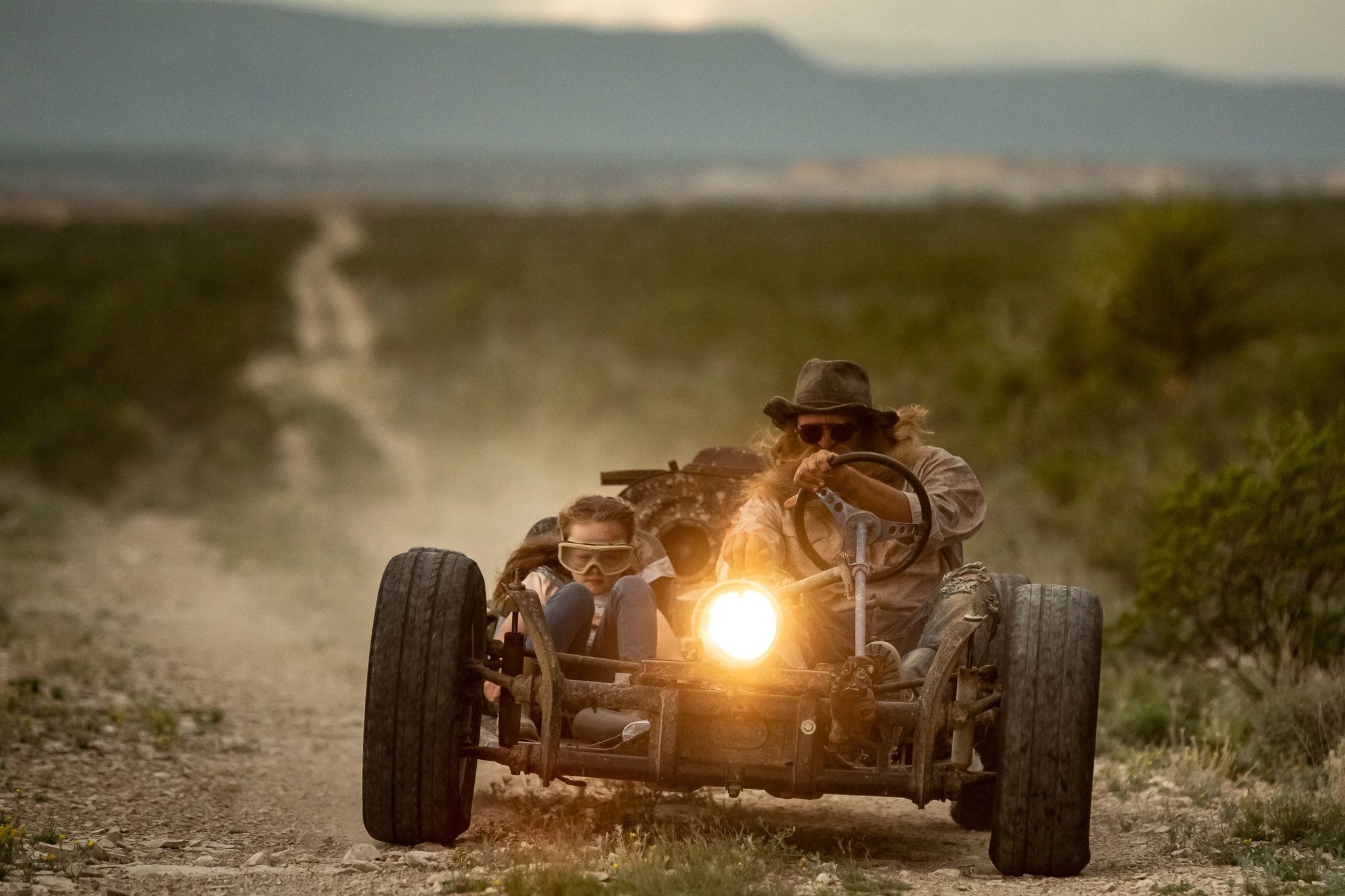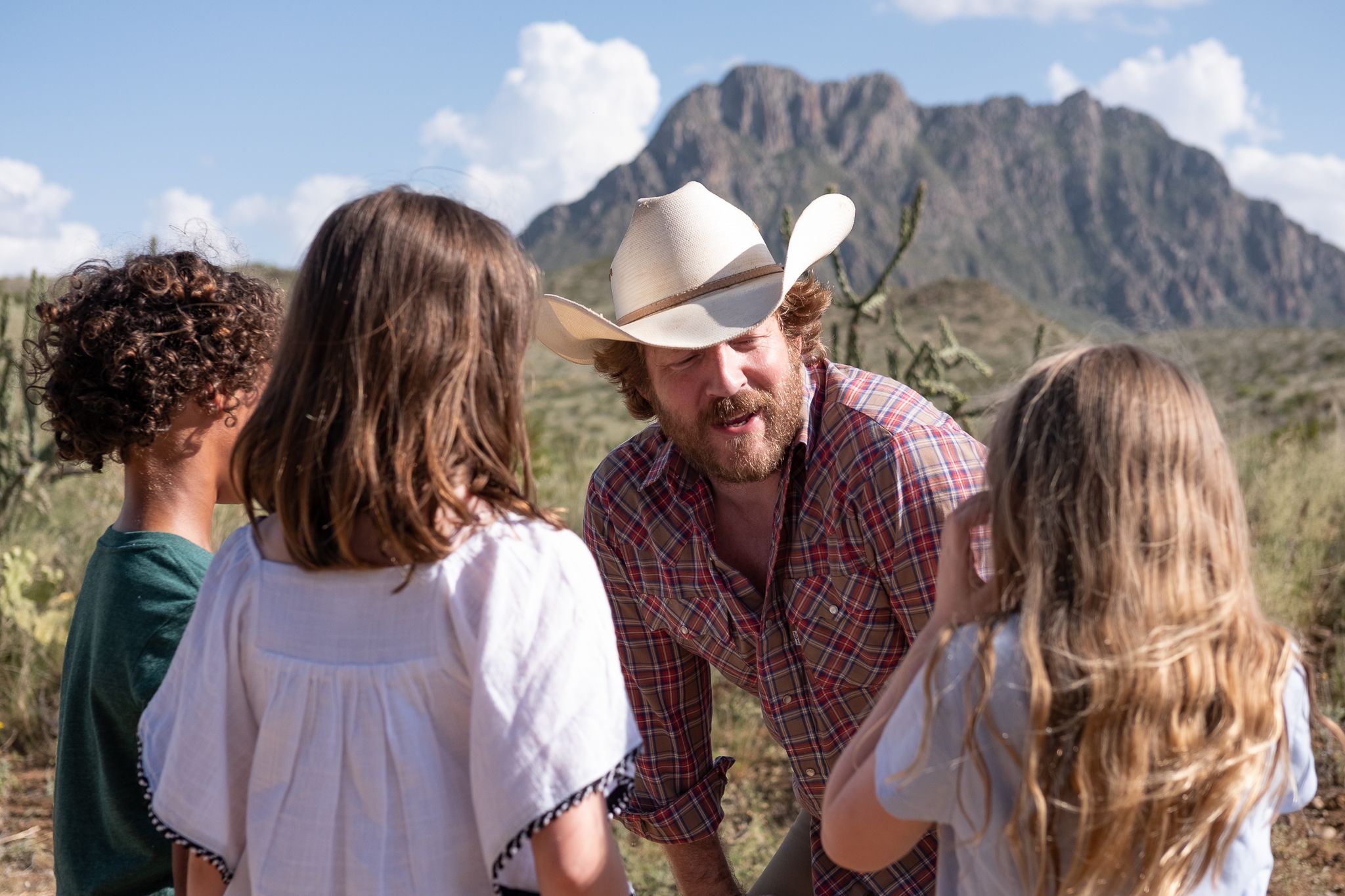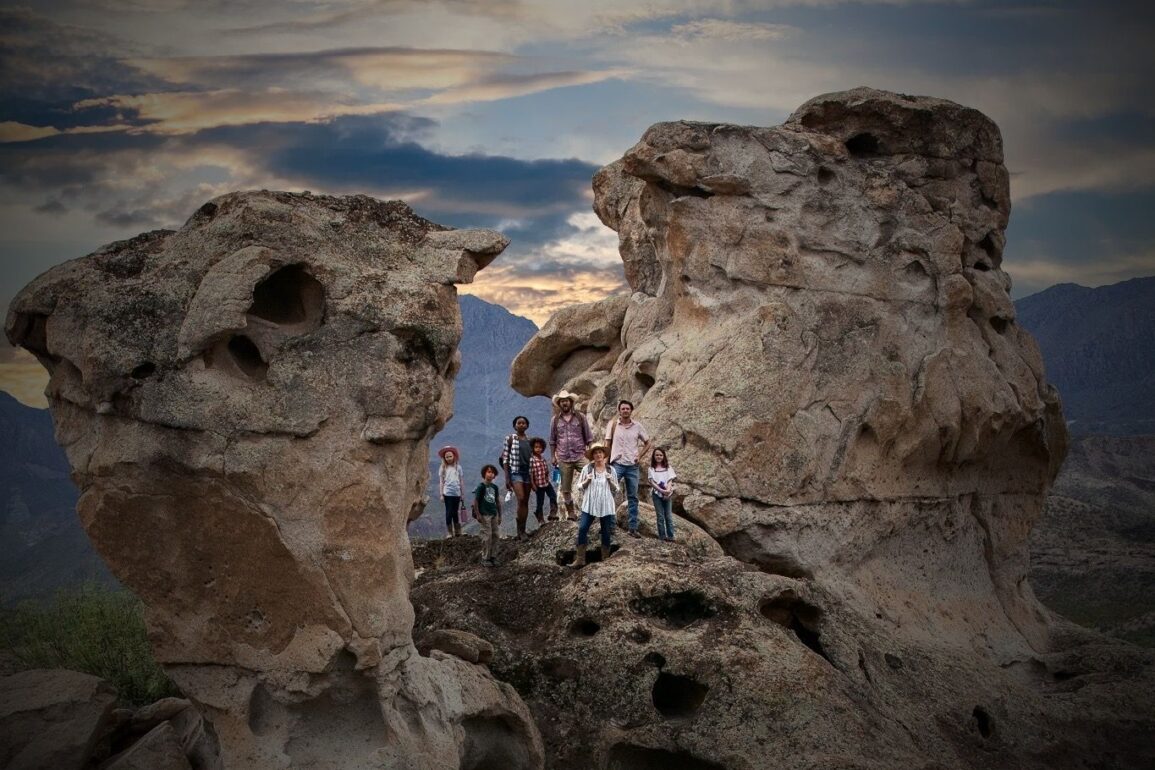Today we’re going to be talking about your new film, The Big Bend, which I loved. I thought it was something new and it was nice to see something that’s unpredictable. I had no idea where the story was going to go. Where did the original idea for The Big Bend come from?
So, the producer Aaron Brown and I have known each other for many years, and we met and worked together in New York. Around the time that I relocated to Hawaii, he returned home to Texas where he grew up. And years passed and we had families, and we hadn’t seen as much of each other and our families hadn’t seen each other at all. We decided to do a vacation out in the West Texas desert. He had gotten a little home out there that he rented out as an Airbnb. So, we met up and we had a really fun adventure. But enough strange, interesting, weird things happened in the course of that trip that I began to think about what a family vacation might be like if both of those families were in crisis, harboring secrets that they wanted to keep under wraps for the sake of having a good time together. And then something goes wrong. And we did, while we were there, lose one of our kids briefly on a hike. Nothing of the order of what happens in the movie, but it was enough to plant the seed of disaster in my mind. And I thought it would be really fun to make a movie with Aaron. We’d wanted to find a project to do together for years. We had actually scouted Big Bend and the region a few years before for a project that he was working on that never happened, although I did write a script for it. And so, I went away, and I wrote this script with the idea of finding something that we could do together to capture the experience of being in that really magical, but also very stark and dangerous place.
Yeah, it’s funny you say magical because I’ve always been drawn to anything that takes place like in the desert. There’s something about it, there’s like the scariness of it, but also, you almost crave the solitude of it. Then there are the ghost lights which is really cool. What do you think the enduring appeal is with people with the desert where the landscape really casts a spell?
First of all, there’s something about being that far away from other people and infrastructure and support and conveniences. We were 300 miles from El Paso, which was the nearest city. We were 80 or 90 miles from Alpine, Texas, which is the nearest thing that could qualify as a town. The only civilization there really was the ranch where we were mostly staying and did a lot of our shooting, which had a lodge and a small hotel and a restaurant. And then ghost town of Terlingua, which had been a mining town up until World War I or something like that. And now it’s got a permanent population of maybe 300 people, picks up a little bit during rafting season. But we were there in the summer, which is not high season down there. It was brutally hot, really difficult time to be there, but it was the only time we could shoot the movie because of the schedules of all the actors. So, I think the isolation casts a spell, but there’s just something in the desert, it’s very alive. It at a glance looks dead, but in fact, it’s teeming with life. Plants everywhere, just cacti, more dangerous plants, and absolutely swarming with snakes and rabbits and lizards and toads. I don’t want to say swarming with mountain lions and things like that, because we never saw one, but they’re out there. You just have a sense that it’s very, very alive, but it’s a different kind of life than you’re used to seeing. It’s as close to being on another planet as you can get on our planet, certainly in our country. And then I think your mind becomes very open to the uncanny. And that’s why there are things like the, the Marfa lights, which have been documented for a hundred years or more as just an inexplicable phenomenon. They built a viewing station. People have been seeing it for decades. But you also don’t know, is my mind tricking me when I see it? Is it really there? The whole place, especially at dusk and dawn, you feel like you’re existing in that liminal state where it’s not quite reality, but you couldn’t quite put your finger on what’s off about it and that’s a feeling that I found very compelling and wanted to capture in the movie. It informed a lot of the writing as well.
I thought you captured that perfectly. That’s why the question came to mind because it just jumped off the screen for me. Now, I don’t want to spoil the scene, but there’s a scene where Jason Butler Horner, who plays Corey, is hanging off that cliff. That looked very real. How was that done?
Yeah. Thank you. It was as real as we could make it. It’s three different types of shots. There’s the big wide shot where you see him as a little tiny figure standing on the edge of an enormous cliff. That is real. He is really on the edge of that cliff. He’s harnessed. But the only thing we did from a visual effects standpoint is paint out the harness that’s keeping him safe. Then there are shots looking up at him. For those, we moved to a similar looking ledge that was just like six feet off the ground and the cameras just on the ground looking up at him. And then the third angle that we have is overhead looking down, which is sort of the really vertiginous one. And that was visual effects. He was still standing on that six-foot ledge and we put a large green screen down and we replaced that with shots we had taken from a drone over the real cliff. We pieced that one together so that he could be looking over the cliff and really feel like he’s taking a risk when he’s as close to the edge as he is. And I’ve watched this movie with audiences at least, I don’t know, 50 or 60 times, maybe more. And I always hear gasps. I feel like this movie has moments for every phobia and fear of heights, fear of snakes, agoraphobia, you name it (laughs). So, I’m really proud of having pulled off both the emotional content of that scene, but also just the visceral experience of being on the edge of a cliff like that.

I’m sure everyone has probably asked this and it’s probably the first thing everyone asked, but I have to ask, can you talk about creating Karl’s car? Can you talk about putting that together?
(laughs) Yeah. So, when I had been down there with my family, we had seen some dune buggies around. I knew that it was a thing that existed there and when we started scouting and prepping for the film, we had a very limited prep. We just couldn’t afford to be there for too many weeks before the shoot. But we did have three, three and a half weeks of scouting and prepping. And we had a wonderful production designer named Suzanne Wyss. This was her first movie and maybe her last because she’s actually changed careers since doing this film, but she was absolutely brilliant. And she found a guy who collected every wrecked Volkswagen he could find. That was that sort of car graveyard that we see Karl walking through. That was just a found location. And the guy who does all that, who also owned the house where Karl hides out, he had a couple of working dune buggies and we picked the one that had the best kind of Mad Max look about it. And between our prep and our shoot, he modified it for us. He added a second seat because there was only one seat. He added brakes because it did not previously have any brakes. And he added seatbelts so that we could safely drive around with a child in the car as well. So, he did some modifications to make it safer. But yeah, that was actually a found object.
You’ve got a great cast, and I particularly thought the script was very natural with the kids. Was there anything improvised there or how did you work with the kids to get such great performances from them?
It was not heavily improvised at all. It was fully scripted. The one area where there would be some improvisation is I realized not so much with the kids, but I realized that there are a lot of scenes where two characters are talking, but there’s eight characters in the room. And because we shot widescreen, those characters are often still in the frame. You don’t really have characters alone in the frame very often when you’re shooting anamorphic as we did. So, the actors would sometimes have to invent non-scripted dialogue to pantomime silently in the background, so it looked like they were talking. Then we’d go back and re-record that wild so that we had it so that when it came time to mix a scene where everybody’s kind of talking over each other, we could do that. The child actors, though, were fully scripted. The boys were cast out of Hollywood. They were pretty experienced, especially the older boy. They’d already done a lot of work, and they were pros. The girls were my daughters and I’d certainly written the script around their personalities and a lot of the lines written in the script are things that I had heard them say, maybe on this vacation or maybe on other occasions. I went through a casting process looking for experienced actors and I really, at a certain point, just thought, hey, maybe my daughters will do a better job. I auditioned them without telling them that I was considering actually casting them and they were great. They were natural. They just both had that understanding of how to not try too hard to just exist in the moment. And I think a lot of the lines felt very natural in their mouths because they’d said similar things, and the personalities were their personalities. And it really just worked out. The kids were the least of our problems.

How was the shoot and did the weather behave itself?
No, the weather did not behave itself (laughs). The weather was our single biggest obstacle. We knew we were going to be in for very, very hot weather, just brutally hot, especially if you’re kind of down in a crevasse, like at the bottom of one of the roughest days was when we were shooting scenes of the kids waiting around after a child has gone missing because we were just baking in a convection oven basically at the bottom of that dry ravine. But we were prepared for that. What we were not prepared for just from inexperience with the region was incredibly intense lightning storms and torrential downpours of rain and heavy hail storms, like sometimes golf ball sized hail pounding us. And very often these big beefy lightning bolts would hit the horizon. We’d have to stop shooting just for safety reasons. We’d try to go to our interior location and then the power would go out to the whole region. And for that reason, this happened on day one of the shoot. We were doing some stuff with Karl and Fiona out in the dune buggy. We got shut down about halfway through our day. We tried to go to our interior location. The power went out, so we had no lights to work with. We could only shoot scenes that we could do with battery operated lights, which meant that on the very first day of the shoot, we wound up shooting the sex scene with Jason Butler-Harner and Virginia Cull, which I’d been planning to do week two, week three, once they were comfortable with each other. We wound up having to do it on the first day because it was dark out there due to the thunderstorm. All we had were lights that could make it look like nighttime. We couldn’t light up the room for day. So yeah, we were struggling against weather. Every week, we got a storm like that, that made a hash of our schedule. And a lot of the locations were also at the end of dirt roads. Some of those dirt roads that are made of this deep, powdery clay would wash out and it would actually take them two or three days before they could be driven again, which would sometimes cost us a location we’d have to find somewhere else to shoot. So, that was by far the hardest thing we dealt with, was weather.
You’ve got some fantastic music in the movie. What role does the music play in creating the film’s atmosphere?
Yeah, I’m really thrilled with how the music turned out. So, there’s a brilliant artist named Shakey Graves, who is Austin based, but he’s kind of known worldwide now. He’s put out a number of great indie style, folk rock albums. I don’t want to categorize it because it’s a little trippier and more psychedelic than that, but really great songwriter. He was involved in the movie from the start. In fact, he has a small part in the movie as an actor playing one of the border patrol guys. First of all, he gave us five songs to use in the movie, a couple of which are originals, just for the movie. Then he also composed some of the instrumental interstitial stuff. And then from there, we worked with a very experienced and equally brilliant composer named Julian Cassia, who was recommended to me by my editor, Katie Ennis and he kind of filled in the overall score. He wrote the opening theme that you hear sort of over that driving scene, that long driving shot that opens the movie, and then that reprises throughout. So, he wrote a lot of the really memorable instrumental music, picking up on instrumentation and an overall vibe that was established by Alejandro and Shakey Graves.
How would you like The Big Bend to resonate with audiences?
Oh, gosh, the first thing you said means a lot to me, which is that it’s unpredictable. I like to watch a character driven drama, but I want to be surprised. I don’t want to feel like it’s arriving right where it needed to arrive, based on what was set up in the first 10 minutes of the movie. I like to be taken on a journey. I like to be introduced to a world that I’m unfamiliar with. I like stories that exist in that space right on the edge of normal life. David Lynch is one of my favorite filmmakers, and certainly I was inspired by him, Wim Wenders, and, he made Paris, Texas in this similar region, very same region, actually. And so I would like the audience to feel a little bit transported, to feel like they’ve been in a strange place, to feel like they’ve lived through a lot of emotions with characters that they may not think are perfect or heroic necessarily, but that they care about. And, to feel like they’ve arrived someplace meaningful. So, yeah, it’s that surprising journey with some twists and turns, a little bit of suspense, a little bit of humor, but ultimately really an emotional through line about just what it means to be an adult, what it means to be married, what it means to have kids, and what it means to be facing a crisis in an unfamiliar landscape.
Wonderful. Well, thank you so much for taking the time to chat, and all the best with the film.
Thank you. My pleasure.






